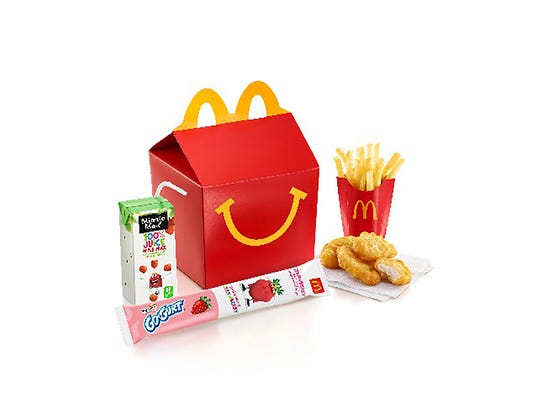McDonald's cheeseburgers in Happy Meals: Now by request only
Zlati Meyer, USA TODAYMcDonald's is making some changes to its Happy Meal that will make it a healthier option by 2022.

(Photo: melinda.west@arcww.com)
McDonald's is making cheeseburgers available in Happy Meals only by request, reducing the portion of french fries that come with Chicken McNuggets and making other changes to its kids' meals to reduce calories, fat and salt.
For some children, the changes may make Happy Meals a little less happy. But they will be more nutritious.
The fast-food giant announced Thursday that by the end of 2022, at least half of Happy Meals listed on menus worldwide will have no more than 600 calories, with 10% of those calories coming from saturated fat and 10% from added sugar. Sodium will be limited as well.
By June, all Happy Meals in the U.S. will hit the calorie, saturated fat and added sugar targets, and 78% will meet its sodium target.
Besides making cheeseburgers available in Happy Meals only if customers request them and reducing the order size of the fries with the six-piece Chicken McNuggets, McDonald's is cutting the amount of added sugar in chocolate milk and adding bottled water as a featured beverage choice on Happy Meal menu boards.
The Oak Brook, Ill.-based company said it also will explore adding new foods to Happy Meals, such as the Junior Chicken, a grilled chicken sandwich McDonald's restaurants in Italy introduced last month.
"It’s a journey. It’s a delicate balance. Customers are looking for options today they can feel good about eating," said Julia Braun, the burger chain's head of global nutrition.
McDonald's said it plans to use marketing, new packaging and order-taking kiosks and mobile apps to promote the healthier food and drink options in Happy Meals.
Currently, 28% of Happy Meal combinations offered on menu boards meet the company's new nutrition criteria in in 20 countries, not only the U.S. and Canada but markets as far-flung as Russia, Hong Kong and Argentina.
McDonald's has made changes in the past to Happy Meals, such as offering apples starting in 2004, excluding soda from the Happy Meal section of its menu boards in 2013 and swapping regular juice for a less caloric and less sugary organic equivalent late last year.
McDonald's doesn't conduct studies on what is actually eaten, rather on what is purchased, Braun explained.
"We want to serve food kids will want to eat," she said. "We do have this opportunity to influence customer choice by what’s presented."
On any given day, one out of three American children eats fast food, and on those days, their daily caloric intake is higher than usual, according to Jennifer Harris of the University of Connecticut's Rudd Center for Food Policy and Obesity. Frequently eating extra calories, especially empty calories, can result in a poor diet and obesity.
While research shows parents like that fast-food chains make healthier options available, the reality shifts dramatically once they walk through the restaurant door.
"A lot of times, the options are available, but they're one choice out of many. If you're in a restaurant and your child smells french fries and sees the soda, it’s very difficult for kids to get the healthier choices," she said. "It increases the perception that these are healthy places, so it's OK to bring your kids there, but once inside, the whole environment is pushing unhealthy options. If you're a parent, do you risk having a meltdown or do you get your child what’s most appealing to them?"
McDonald's stock closed at $159.99, down $2.41 or 1.48%, on Wednesday.
McDonald’s plans to go green by 2025. Time
No comments:
Post a Comment